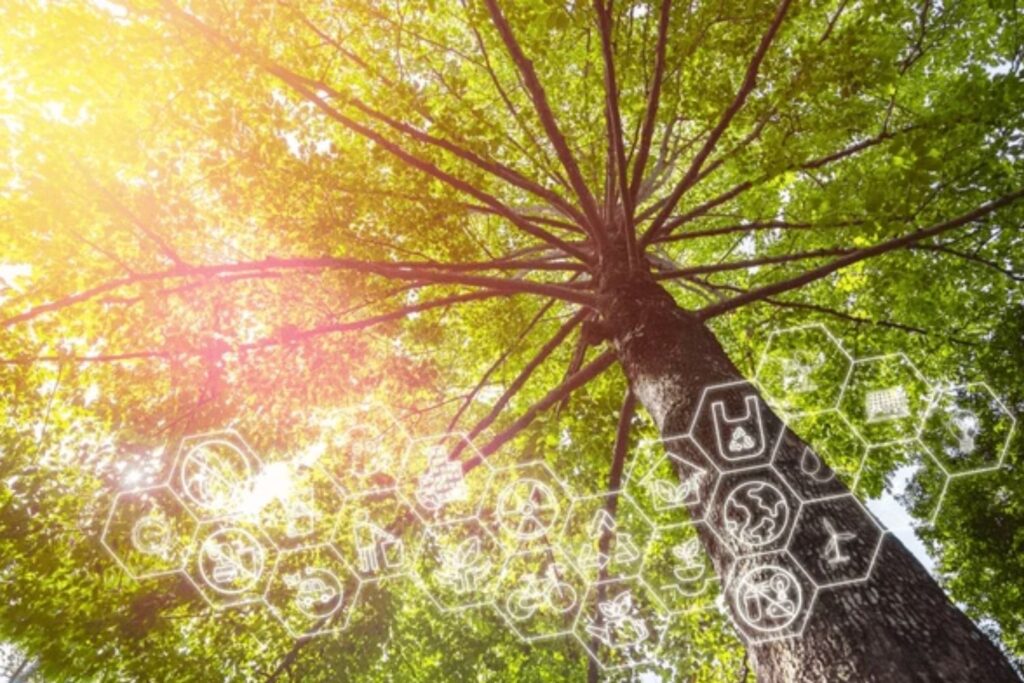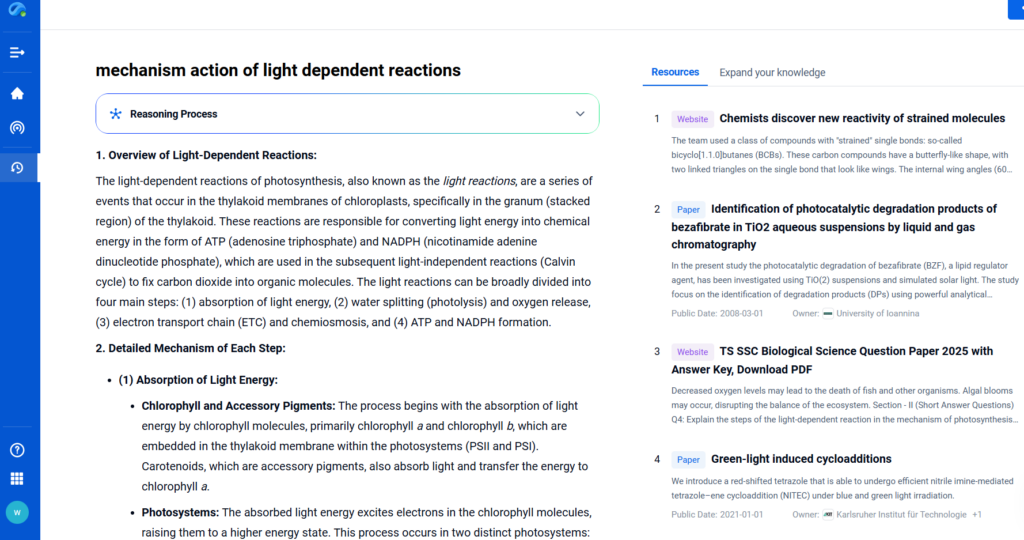
Light-dependent reactions form the initial phase of photosynthesis, a process through which green plants, algae, and some bacteria convert sunlight into chemical energy. These reactions require light to occur, hence the name. They take place in the thylakoid membranes of the chloroplasts and are responsible for producing two essential energy carriers: ATP (adenosine triphosphate) and NADPH (nicotinamide adenine dinucleotide phosphate). These molecules then power the second phase of photosynthesis—the light-independent or Calvin Cycle.
With the help of tools like PatSnap Eureka AI Agent, researchers can trace the latest innovations and patents in synthetic photosynthesis, chloroplast protein engineering, and ATP-synthase mimetics to understand and replicate this natural energy-converting mechanism.
What is Light-Dependent Reactions
Light-dependent reactions are the first stage of photosynthesis and require sunlight to take place. These reactions occur in the chloroplasts, specifically within the thylakoid membranes. More precisely, they take place in the granum, which are stacks of thylakoids. During this process, light energy is converted into chemical energy. This energy is stored in two molecules: ATP (adenosine triphosphate) and NADPH (nicotinamide adenine dinucleotide phosphate). These two products are essential for the next stage of photosynthesis—the light-independent reactions, also known as the Calvin cycle. In that stage, plants use the stored energy to fix carbon dioxide into sugars.

Where It Happens: The Thylakoid Membrane
Chloroplasts, the energy factories of plant cells, contain disk-like structures known as thylakoids, which stack into grana. The thylakoid membrane hosts the protein complexes and pigments necessary for capturing light and driving the reactions.
Key protein complexes embedded in the thylakoid membrane include:
- Photosystem II (PSII)
- Cytochrome b6f complex
- Photosystem I (PSI)
- ATP Synthase
These components interact with pigments such as chlorophyll a, chlorophyll b, and carotenoids to absorb light, transfer energy, and carry electrons across the membrane.
Key Components Involved
Photosystem II (PSII)
This is the starting point of the light-dependent reactions. When PSII absorbs photons, it excites electrons and extracts them from water molecules through a process called photolysis, generating O₂ as a by-product.
Electron Transport Chain (ETC)
The high-energy electrons move through a series of proteins in the membrane, including plastoquinone (PQ) and cytochrome b6f, which facilitate proton pumping across the membrane, contributing to a proton gradient.
Photosystem I (PSI)
Electrons from PSII eventually reach PSI, where they are re-energized by more photons. These re-energized electrons are then transferred to NADP⁺, reducing it to NADPH with the help of the enzyme NADP⁺ reductase.
ATP Synthase
Protons that accumulate in the thylakoid lumen flow back into the stroma through ATP synthase, which harnesses this proton motive force to synthesize ATP from ADP and Pi.
Mechanism of Action
The light-dependent reactions of photosynthesis are also called the light reactions. They take place in the thylakoid membranes of chloroplasts. Specifically, they occur in the granum—the stacked region of the thylakoid. These reactions convert light energy into chemical energy. The energy is stored in ATP and NADPH molecules. ATP stands for adenosine triphosphate. NADPH stands for nicotinamide adenine dinucleotide phosphate. Both are used in the Calvin cycle, also called light-independent reactions.
In that cycle, plants fix carbon dioxide into organic molecules. The light reactions include four major steps:
(1) Absorption of light energy.
(2) Splitting of water molecules (photolysis) and release of oxygen.
(3) Electron transport through the electron transport chain (ETC) and chemiosmosis.
(4) Formation of ATP and NADPH.
Detailed Mechanism of Each Step
(1) Absorption of Light Energy:
- Chlorophyll and Accessory Pigments: The process begins with the absorption of light energy by chlorophyll molecules, primarily chlorophyll a and chlorophyll b, which are embedded in the thylakoid membrane within the photosystems (PSII and PSI). Carotenoids, which are accessory pigments, also absorb light and transfer the energy to chlorophyll a.
- Photosystems: The absorbed light energy excites electrons in the chlorophyll molecules, raising them to a higher energy state. This process occurs in two distinct photosystems: Photosystem II (PSII) and Photosystem I (PSI), which work in tandem.
- Excitation Energy Transfer: The energy from the excited electrons is transferred through a series of pigments within the photosystem, a process known as resonance energy transfer, until it reaches the reaction center chlorophyll.
(2) Water Splitting (Photolysis) and Oxygen Release:
- Role of PSII: In PSII, the excited electrons are used to reduce a primary electron acceptor, pheophytin.
- Water-Splitting Enzyme Complex: The loss of electrons from PSII is replenished by the splitting of water molecules, a process catalyzed by the oxygen-evolving complex (OEC) associated with PSII. This reaction splits water into oxygen (O₂), protons (H⁺), and electrons (e⁻).
- Oxygen as a Byproduct: The oxygen produced is released as a byproduct into the atmosphere.
(3) Electron Transport Chain (ETC) and Chemiosmosis:
- Electron Carriers: The electrons from PSII are transferred through a series of electron carriers, including plastoquinone (PQ), the cytochrome b₆f complex, and plastocyanin (PC), which form the electron transport chain between PSII and PSI.
- Proton Pumping: As electrons move through the cytochrome b₆f complex, energy is released and used to pump protons (H⁺) from the stroma into the thylakoid lumen, creating a proton gradient across the thylakoid membrane.
- Photosystem I (PSI): The electrons are then transferred to PSI, where they are re-energized by light absorption.
- Final Electron Acceptors: The high-energy electrons from PSI are used to reduce ferredoxin (Fd), a soluble electron carrier in the stroma.
(4) ATP and NADPH Formation:
- ATP Synthase: The proton gradient established across the thylakoid membrane drives the synthesis of ATP from ADP (adenosine diphosphate) and inorganic phosphate (Pi) via the enzyme ATP synthase, a process known as photophosphorylation.
- NADP⁺ Reduction: Ferredoxin transfers its electrons to NADP⁺ reductase, an enzyme bound to the thylakoid membrane, which catalyzes the reduction of NADP⁺ to NADPH using the electrons and protons (H⁺).
Cyclic and Non-Cyclic Photophosphorylation:
- Non-Cyclic Photophosphorylation: This is the most common pathway, involving both PSII and PSI, and results in the production of ATP, NADPH, and oxygen.
- Cyclic Photophosphorylation: This pathway involves only PSI and results in the production of ATP without the release of oxygen or the formation of NADPH.
Regulation and Stress Responses:
- Short-Term Responses: Plants have mechanisms to regulate the distribution of light energy between PSII and PSI, such as the state transitions that involve the phosphorylation and dephosphorylation of light-harvesting complex II (LHCII) proteins.
- Long-Term Adaptations: Plants can also adjust to different light conditions through long-term adaptations, such as changes in the composition and organization of the photosynthetic apparatus.
- Photoprotection: Under high light stress, plants activate photoprotective mechanisms, such as non-photochemical quenching (NPQ), to dissipate excess light energy and prevent damage to the photosynthetic machinery.
Outputs and Their Role in the Calvin Cycle
The ATP and NADPH produced are not the final products of photosynthesis but crucial intermediates. They are used in the Calvin Cycle (light-independent reactions) to fix carbon dioxide into glucose and other carbohydrates.
Think of light-dependent reactions as a solar-powered battery charger: they store energy in chemical form, ready to fuel the synthesis of life’s essential sugars.
Real-World Relevance & Applications
- Agricultural Engineering: Increasing the efficiency of photosystems to improve crop yield.
- Bioenergy: Developing artificial photosynthesis systems to mimic nature’s energy conversion.
- Climate Solutions: Enhancing carbon fixation through optimized light reactions may contribute to carbon sequestration.
For instance, recent efforts in synthetic biology are focused on designing artificial thylakoid membranes or embedding light-harvesting complexes into biohybrid systems. Eureka AI Agent allows R&D teams to explore these advances through real-time tracking of patent filings and scientific publications.
Innovation & Recent Research
Researchers are pushing boundaries in fields such as:
- Genetic Engineering of Chloroplasts: Enhancing light harvesting or resilience to heat stress.
- Artificial Photosynthesis Systems: Using semiconductors and catalysts to replicate the light-dependent reactions.
- Nano-bio Interfaces: Embedding photosystems into bioelectronic devices.
Patsnap Eureka AI Agent Capabilities
With PatSnap Eureka AI Agent, users can:
- Explore patent landscapes in chloroplast engineering and light-driven catalysis.
- Identify leading institutions working on ATP synthase optimization.
- Analyze technological convergence between biology and solar-energy sectors.
For example, searching for “ATP synthase biohybrid” reveals collaborations between academic labs and clean energy startups worldwide.
Conclusion
The light-dependent reactions of photosynthesis are a marvel of natural engineering. By converting sunlight into chemical energy, they form the foundation of life on Earth and hold immense potential for addressing today’s challenges—from food security to sustainable energy.
Through advanced tools like PatSnap Eureka AI Agent, scientists and innovators can harness this knowledge to fuel breakthroughs in agriculture, energy, and beyond.
FAQs
Yes. They require sunlight to activate photosystems, so they only occur in light conditions.
Despite the numbering, PSII functions first in the light reaction chain.
No. They produce ATP and NADPH, which are then used in the Calvin Cycle to synthesize glucose.
To get detailed scientific explanations of the light-dependent reactions, try Patsnap Eureka.




